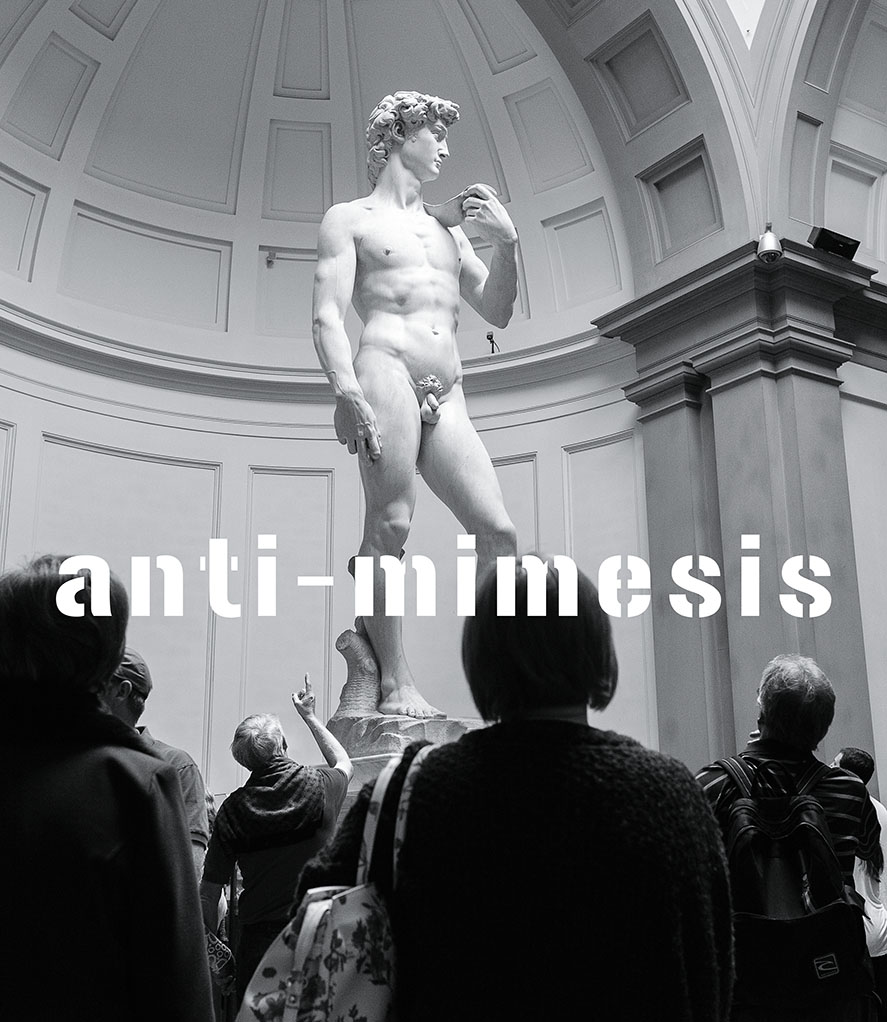
I posted the above image on my social media account and had a comment from a freind that set me thinking. Angus’ comment simply said ‘Are you sure its not diegesis?’
With the typical self doubt of a creative producer, I thought am I?
I spent significant time thinking about the inception of this piece of work. So I felt confident I had made the right decision. This entry will take a closer look at the history and contexts of the issues it draws upon, if only to set it straight in my mind.
The two words we are examining are ‘diegesis’ and ‘mimesis’ and how they do or do not apply to this image. The two terms are from drama and narrative theory and are credited as having been introduced by Socrates in relation to Plato’s Republic 329c ff. to help categorise different ways of presenting a story. In the stated instance it denotes narrative in the wider generic sense of discourse that communicates information keyed to a temporal framework (events “past, present, or future,” Republic 392d). Contemporary usage has converted diegesis into a narratological category denoting the imagined story-universe as opposed to the discursive or textual constituents of a narration. (Halliwell 2012).
Diegesis is derived from a Greek verb diegeisthai which means literally “to lead/guide through”. It came to mean “give an account”, and “narrate”. Together with the verb, the noun diegesis itself became established in the 5th century BC as a common term for acts of verbal narration (Halliwell 2012)
In the Aesthetics of Mimesis, Halliwell states that mimesis has a more complex early history. Socrates employed it to varying degrees of inclusivity to those involved in visual arts, poetry, drama and music as producers of mimesis. Aristotle used the term as the master concept of representational art forms.
In Plato’s own practices as a writer, a diegesis/mimesis distinction came to be used in antiquity to classify the discursive forms of the Platonic dialogues themselves (Halliwell 2012).
To paraphrase Halliwell (2014) in short diegesis can be defined as narrative/narration the story is told rather than shown. To show is the domain of mimesis which is imitation, representation or enactment. To distill it further Diegesis is tell. Mimesis is show (Tim Ralphs 2014).
Now lets consider how these terms relate to this image amd the issues they invoke.
Many terms are used and occasionally debated in the description of photographic output. A term I often hear or see is the idea of ‘narrative in the still image’.
As someone who uses photography and documents scenes before me its tempting to see me as a kind of narrator of life in those individual scenes; and I suppose by implication, my life, through my presence at the taking. Implicit in this assertion seems to be the idea that those still images have a narrative.
However, this is a confusion of ‘narrative’ with a search to make ‘meaning’. It is self evident in the most literal sense that my voice is absent from this work as in every other still image I have made; but what is a recognised definition of ‘narrative’?
In Narrative Intelligence (2003) Jerome Bruner is referenced for his description of ‘narrative diachronicity’; a narrative is an account of events occurring over time. He believes it to be irreducibly durative. Events that are understood by the way they relate over time.
My image shows an impressive statue (Michelangelo’s ‘David’) even if we do not know its creator. We can speculate its setting as a gallery/museum through the grand architecture, security cameras and crowd of admirers. Nearest to the sculpture with its down pointed fingers, reminiscent of how Michelangelo illustrated hands in much of his work, we see a male figure seemingly reciprocating this gesture and pointing up. As is the single images forte it is expository in its description. That is its best base function as still imagery, having no durative element beyond how long you choose to gaze at it.
An image may prompt a connection to a story you know, or cause you to invent one from the elements within the image. As with Henri Cartier Bresson’s ‘decisive moment’ it could be described as an enigma to be solved (Mark Meyer).
The photograph as with my description is demonstrating or in this specific case imitating a scene (Michelangelo’s fresco ‘The Creation of Adam’), which leads us onto its basis in mimesis. Not however, Aristotle’s mimesis, of art imitating life. In the case of anti mimesis a notable use in culture was by Oscar Wilde in his essay of 1889 titled ‘The Decay of Lying’ (written as Platonic dialogue) he states that “life imitates art far more than art imitates life”. Which is pleasingly circular in bringing us back to the search for meaning, in this instance, meaning expressed as art imitating life in an everyday scene.
Halliwell, Stephen (2012) The Living Handbook of Narratology. (viewed 20-03-17)
Available from: http://wikis.sub.uni-hamburg.de/lhn/index.php/Diegesis_-_Mimesis
Ralphs, Tim (2014) Mimesis and Diegesis. (viewed 20-03-17)
Available from: http://www.timralphs.com/mimesis-and-diegesis
Meyer, Mark. Storytelling Photography Considered Harmful (viewed 17-01-17)
Available from: http://www.photo-mark.com/notes/storytelling-photography-considered-harmful/
Bruner , Jerome (2003) The Narrative Construction of Reality, Narrative Intelligence.
Editors; Michael Mateas, Phoebe Sengers. Amsterdam/Philadelphia; John Benjamins Publishing Company.